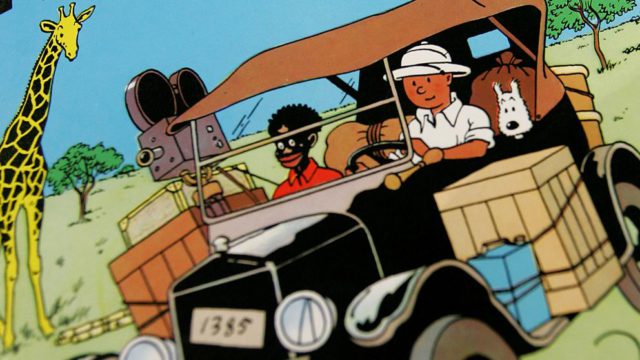01 in the Land of the Soviets Tintin in the Congo Original Black White Art

Some Tintin comics take been criticised for transmitting racist or partisan ideas of colonialism
Hergé created The Adventures of Tintin for an audience of children, but over time some of his stories have been criticised for the ideas and stereotypes they transmitted.
The showtime Tintin comic strips appeared in 1929 in Le Petit Vingtième, the children's department of Le Vingtième Siècle, a conservative and very religious Belgian newspaper. The director, Norbert Wallez, was a priest and announcer who asked Hergé to create a character that would spread Catholic values among children.
In 'Tintin in the State of the Soviets' , the young reporter travels to Moscow to write an article about the new communist authorities. Influenced by the newspaper'due south editorial direction, Hergé filled the first Tintin comic with anti-Communist messages.
ten de enero de 1929. Se inicia la publicación de Tintín en el País de los Soviets. Estas son dos de mis páginas preferidas. pic.twitter.com/XWZpCKRCVj
— Philmore A. Mellows (@PhilAMellows) January 10, 2018
Over time, Hergé recognised that he let himself be carried away by his own prejudices in that commencement comic. The creative person came from a wealthy family and never questioned what his bosses at the newspaper told him.
Belgian colonialism in the Congo
Hergé was as well criticised for his colonialist and racist views in stories similar 'Tintin in the Congo' , a story first published in black and white in 1931.
In this example, Wallez asked him to place the story in the Congo, which had been a Belgian colony since 1908. The aim was to give a positive view of the Belgian occupation and evangelisation existence carried out past the Church building in Africa.
The terminate of Earth War II (1940-1945) also marked the end of the colonial era. At that time, the first criticisms against the comic appeared due to the racist clarification of Africans.
In 1946, Hergé created a new version of the story in color, removing the most controversial vignettes and texts. Even so, the controversy has remained to this twenty-four hour period.
In 2007, the United kingdom Committee for Racial Equality asked that the book be removed from bookstores, although in the end information technology remained on the status that the publisher include a alarm message regarding its contents. In 2011, the work Tintin in the Congo was put on trial in Belgium for racism.
Tintín ha sido señalado como united nations personaje con una clara concepción racista, colonialista y fascista, en donde se exalta al colonizador: "¡Hombre blanco muy grande! Tiene buenos espíritus" Las aventuras de Tintín fueron llevadas al cine por Spielberg en el 2011 con tres historias movie.twitter.com/VDbvA2EM7x
— MEMORABLE (@EsMemorable) Jan eleven, 2018
Comfort or ignorance?
Hergé had to face up these accusations until his death in 1983. According to him, when he drew the first Tintin stories, during the decades of the 1930s and 1940s, there was no social awareness of racial and cultural stereotypes.
In that sense, the racist comments and devil-may-care representation of some characters are a reflection of the ignorance that existed at that fourth dimension, when the internet and social networks had not yet been invented.
All the same, Hergé did use some of his stories to echo conflicts and injustices like the slave trade (The Red Sea Sharks), the arms trade and guerrillas (The Cleaved Ear, Tintin and the Picaros) or conspiracies betwixt governments (Male monarch Ottokar'south Sceptre).
Stock de coque #tintín los malos son muy malos y hay "buenos" que no se sabe en qué bando deberían estar pic.twitter.com/aJZv5eBO3V
— Juan Royo Abenia (@juanroyoabenia) April 20, 2014
To defend his piece of work, Tintin fans refer to works like 'The Blue Lotus' (1936). Hergé wrote this comic with the help of Zhang Chongren, a Chinese pupil who helped him educate himself in gild to not nowadays the typical stereotypes of Chinese civilisation.
The comic was considered one of the 100 all-time books of the 20th century by the French paper Le Monde.
Made into a graphic symbol, Zhang reappears in Tintin in Tibet, the story of two friends from different cultures and the power of friendship to move mountains (or to overcome whatever obstacle, no thing how high).
Stay informed with Junior Study| Castellano | Català |English language
0 Response to "01 in the Land of the Soviets Tintin in the Congo Original Black White Art"
Post a Comment